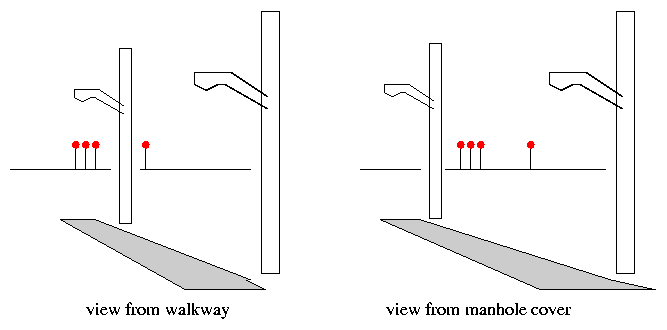
 Copyright © Michael Richmond.
This work is licensed under a Creative Commons License.
Copyright © Michael Richmond.
This work is licensed under a Creative Commons License.
Knowing the distance to a star or planet is necessary to determine several of its properties (size, mass, density, luminosity) ... but is also difficult to measure. Celestial objects are inaccessible: we can't visit them ourselves, or (in the case of stars and galaxies) even send robotic vehicles to them. Therefore, astronomers have devised a number of schemes to measure distances indirectly. You will use the best of them tonight: the parallax method.
If one looks at the same nearby object from different locations, it will appear to shift side-to-side relative to more distant objects. You can see the effect yourself by holding one arm out in front of you, pointing at some feature on a distant wall. Raise one finger on the hand. Close your left eye, and note the position of your finger relative to the wall. Then open your left eye, and close your right eye: your finger will appear to have moved relative to features on the wall.
Planets and stars are too far away to show shifts as you shift from one eye to the other ... but they do display apparent motion if you use longer baselines. One possibility is to arrange for two observers far apart on the Earth -- say, Rochester and San Francisco -- to observe an object simultaneously: a baseline of several thousand miles permits them to see a shift in the apparent position of asteroids and planets relative to the stars. Another technique is to make observations of a star six months apart, as the Earth moves from one side of the Sun to the other in its orbit: this baseline of almost two hundred million miles will reveal small shifts in the apparent positions of nearby stars relative to more distant ones.
Your task to is measure the distance to a streetlight along the sidewalk in front of the RIT Observatory. I have marked two spots for you to stand: one is on a manhole cover in the Observatory's front yard, near the driverway, and the other is in the middle of the walkway to the Observatory's front door, directly across from the manhole cover. From each spot, you should be able to see the streetlight and, behind it, some red lights on radio antennae on the distant horizon. You should see a group of three red lights close together, and a single red light some distance to the right. One streetlight will be very close to you, just across the driveway; don't pick that one. Instead, concentrate on the SECOND streetlight, further north along the sidewalk.
You must measure the angular shift of the streetlight relative to the single, isolated red light. Assume the antenna's direction is fixed, and measure the total angular motion, in degrees, by which the streetlight appears to move. You will have a simple device with which to measure angles: a meter stick with a centimeter scale on a cross-piece attached to one end.
Last modified Oct 16, 2003 by MWR
 Copyright © Michael Richmond.
This work is licensed under a Creative Commons License.
Copyright © Michael Richmond.
This work is licensed under a Creative Commons License.